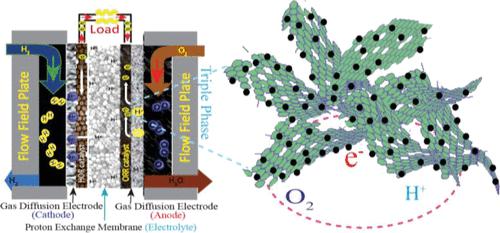当前位置:
X-MOL 学术
›
ACS Appl. Mater. Interfaces
›
论文详情
Our official English website, www.x-mol.net, welcomes your
feedback! (Note: you will need to create a separate account there.)
Microporous 3D-Structured Hierarchically Entangled Graphene-Supported Pt3Co Alloy Catalyst for PEMFC Application with Process-Friendly Features
ACS Applied Materials & Interfaces ( IF 8.3 ) Pub Date : 2023-06-02 , DOI: 10.1021/acsami.3c03372 Narugopal Manna 1, 2 , Mayank Singh 1, 2 , Sreekumar Kurungot 1, 2
ACS Applied Materials & Interfaces ( IF 8.3 ) Pub Date : 2023-06-02 , DOI: 10.1021/acsami.3c03372 Narugopal Manna 1, 2 , Mayank Singh 1, 2 , Sreekumar Kurungot 1, 2
Affiliation

|
To improve the oxygen reduction reaction (ORR) performance in a proton-exchange membrane fuel cell (PEMFC) cathode with respect to mass activity and durability, a suitable electrocatalyst design strategy is essentially needed. Here, we have prepared a sub-three nm-sized platinum (Pt)–cobalt (Co) alloy (Pt3Co)-supported N-doped microporous 3D graphene (Pt3Co/pNEGF) by using the polyol synthesis method. A microwave-assisted synthesis method was employed to prepare the catalyst based on the 3D porous carbon support with a large pore volume and dense micro-/mesoporous surfaces. The ORR performance of Pt3Co/pNEGF closely matches with the state-of-the-art commercial Pt/C catalyst in 0.1 M HClO4, with a small overpotential of 10 mV. The 3D microporous structure of the N-doped graphene significantly improves the mass transport of the reactant and thus the overall ORR performance. As a result of the lower loading of Pt in Pt3Co/pNEGF as compared to that in Pt/C, the alloy catalyst achieved 1.5 times higher mass activity than Pt/C. After 10,000 cycles, the difference in the electrochemically active surface area (ECSA) and half-wave potential (E1/2) of Pt3Co/pNEGF is found to be 5 m2 gPt–1 (ΔECSA) and 24 mV (ΔE1/2), whereas, for Pt/C, these values are 9 m2 gPt–1 and 32 mV, respectively. Finally, in a realistic perspective, single-cell testing of a membrane electrode assembly (MEA) was made by sandwiching the Pt3Co/pNEGF-coated gas diffusion layers as the cathode displayed a maximum power density of 800 mW cm–2 under H2–O2 feed conditions with a clear indication of helping the system in the mass-transfer region (i.e., the high current dragging condition). The nature of the I–V polarization shows a progressively lower slope in this region of the polarization plot compared to a similar system made from its Pt/C counterpart and a significantly improved performance throughout the polarization region in the case of the system made from the Pt3Co/NEGF catalyst (without the microwave treatment) counterpart. These results validate the better process friendliness of Pt3Co/pNEGF as a PEMFC electrode-specific catalyst owing to its unique texture with 3D architecture and well-defined porosity with better structural endurance.
中文翻译:

用于 PEMFC 应用的微孔 3D 结构分层缠结石墨烯负载 Pt3Co 合金催化剂,具有工艺友好的特性
为了提高质子交换膜燃料电池 (PEMFC) 阴极在质量活性和耐久性方面的氧还原反应 (ORR) 性能,必须采用合适的电催化剂设计策略。在这里,我们通过使用多元醇合成方法制备了亚三纳米尺寸的铂 (Pt)-钴 (Co) 合金 (Pt 3 Co) 负载的 N 掺杂微孔 3D 石墨烯 (Pt 3 Co/pNEGF)。采用微波辅助合成方法制备基于具有大孔体积和致密微/中孔表面的 3D 多孔碳载体的催化剂。Pt 3 Co/pNEGF在 0.1 M HClO 4中的 ORR 性能与最先进的商用Pt/C 催化剂非常接近,具有 10 mV 的小过电势。N 掺杂石墨烯的 3D 微孔结构显着改善了反应物的传质,从而提高了整体 ORR 性能。由于与Pt/C 相比, Pt 3 Co/pNEGF 中的 Pt 载量较低,合金催化剂的质量活性比 Pt/C 高 1.5 倍。10,000 次循环后,发现Pt 3 Co/pNEGF 的电化学活性表面积 (ECSA) 和半波电位 ( E 1/2 ) 的差异为 5 m 2 g Pt –1 (ΔECSA) 和 24 mV ( Δ E 1/2 ),而对于 Pt/C,这些值为 9 m 2 g Pt –1和 32 mV,分别。最后,从现实的角度来看,通过将 Pt 3 Co/pNEGF 涂层气体扩散层夹在中间对膜电极组件 (MEA) 进行单电池测试,因为阴极在 H 下显示出 800 mW cm –2的最大功率密度2 –O 2进料条件清楚地表明有助于系统进入传质区域(即高电流拖曳条件)。I - V极化的性质表明,与由其 Pt/C 对应物制成的类似系统相比,极化图的该区域的斜率逐渐降低,并且在由 Pt/C 制成的系统的情况下,整个极化区域的性能显着提高铂3 Co/NEGF 催化剂(未经微波处理)对应物。这些结果证实了 Pt 3 Co/pNEGF 作为 PEMFC 电极专用催化剂具有更好的工艺友好性,因为其具有 3D 结构的独特纹理和明确定义的孔隙率以及更好的结构耐久性。
更新日期:2023-06-02
中文翻译:

用于 PEMFC 应用的微孔 3D 结构分层缠结石墨烯负载 Pt3Co 合金催化剂,具有工艺友好的特性
为了提高质子交换膜燃料电池 (PEMFC) 阴极在质量活性和耐久性方面的氧还原反应 (ORR) 性能,必须采用合适的电催化剂设计策略。在这里,我们通过使用多元醇合成方法制备了亚三纳米尺寸的铂 (Pt)-钴 (Co) 合金 (Pt 3 Co) 负载的 N 掺杂微孔 3D 石墨烯 (Pt 3 Co/pNEGF)。采用微波辅助合成方法制备基于具有大孔体积和致密微/中孔表面的 3D 多孔碳载体的催化剂。Pt 3 Co/pNEGF在 0.1 M HClO 4中的 ORR 性能与最先进的商用Pt/C 催化剂非常接近,具有 10 mV 的小过电势。N 掺杂石墨烯的 3D 微孔结构显着改善了反应物的传质,从而提高了整体 ORR 性能。由于与Pt/C 相比, Pt 3 Co/pNEGF 中的 Pt 载量较低,合金催化剂的质量活性比 Pt/C 高 1.5 倍。10,000 次循环后,发现Pt 3 Co/pNEGF 的电化学活性表面积 (ECSA) 和半波电位 ( E 1/2 ) 的差异为 5 m 2 g Pt –1 (ΔECSA) 和 24 mV ( Δ E 1/2 ),而对于 Pt/C,这些值为 9 m 2 g Pt –1和 32 mV,分别。最后,从现实的角度来看,通过将 Pt 3 Co/pNEGF 涂层气体扩散层夹在中间对膜电极组件 (MEA) 进行单电池测试,因为阴极在 H 下显示出 800 mW cm –2的最大功率密度2 –O 2进料条件清楚地表明有助于系统进入传质区域(即高电流拖曳条件)。I - V极化的性质表明,与由其 Pt/C 对应物制成的类似系统相比,极化图的该区域的斜率逐渐降低,并且在由 Pt/C 制成的系统的情况下,整个极化区域的性能显着提高铂3 Co/NEGF 催化剂(未经微波处理)对应物。这些结果证实了 Pt 3 Co/pNEGF 作为 PEMFC 电极专用催化剂具有更好的工艺友好性,因为其具有 3D 结构的独特纹理和明确定义的孔隙率以及更好的结构耐久性。











































 京公网安备 11010802027423号
京公网安备 11010802027423号